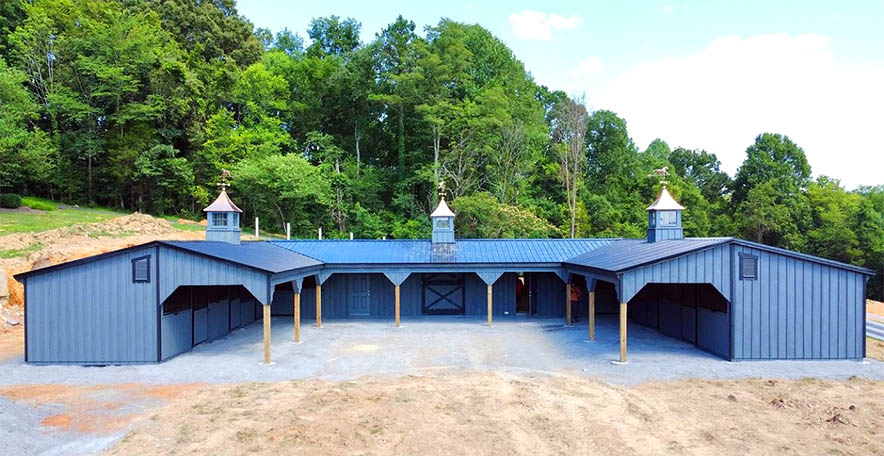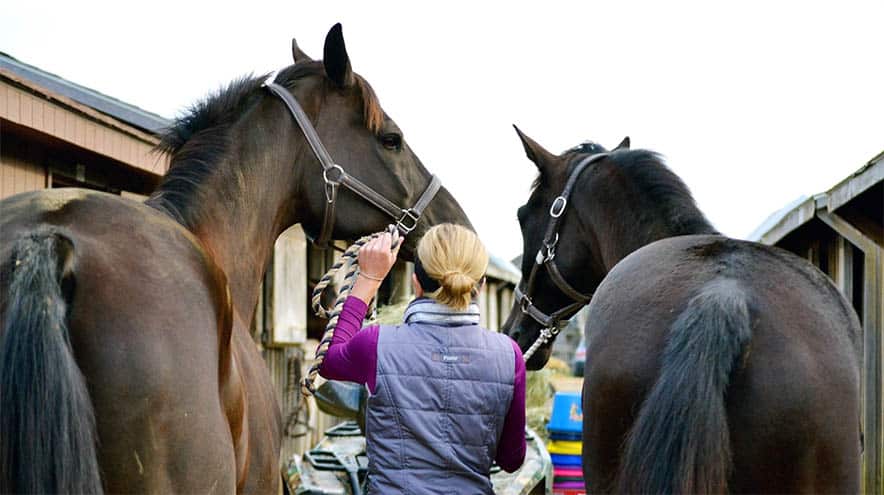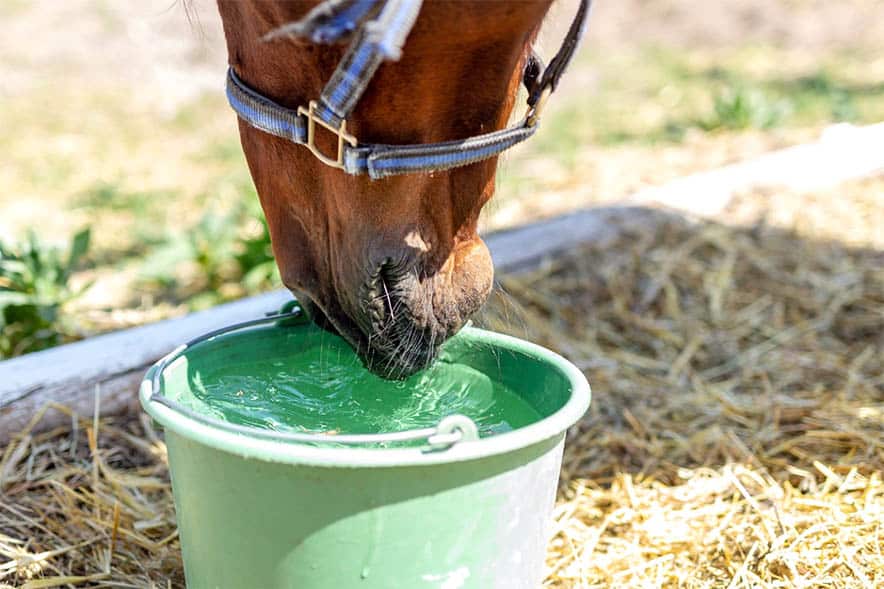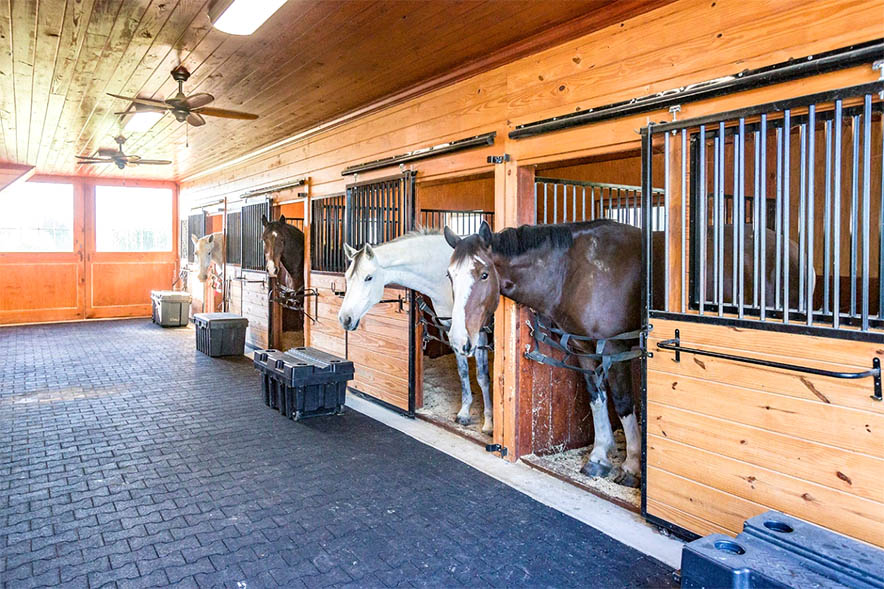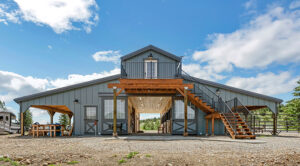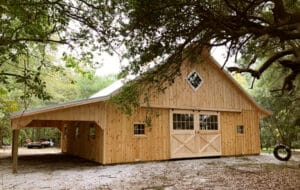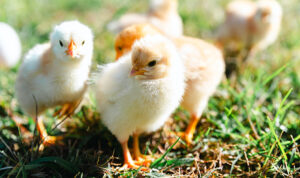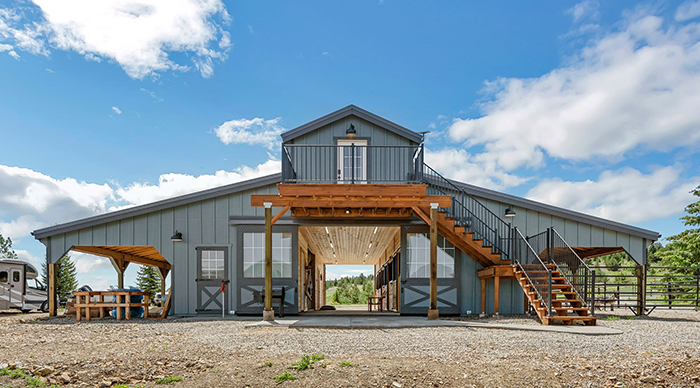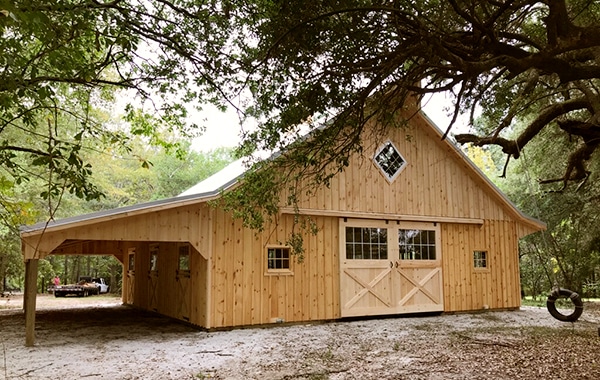It is not easy to juggle the challenges of training horses and running a busy barn at home while also getting out on the road and competing against your peers. Horses that are working at different performance levels have very different requirements in their daily care.
Addressing the special needs of competition horses, such as horse barn management, is an essential component of ensuring they are fit and healthy and at peak levels of performance when the time comes to showcase their talents in the arena. To optimize these horses’ care, it makes sense to plan your barn design to factor in how to best manage these needs. The goal is to make sure these noble athletes are kept as happy and content as possible while also maintaining good horse keeping for the equines that stay home.
Performance horses that are out and about can bring home more than just ribbons. Contagious diseases are just one concern. Injuries, soreness, stress, and anxiety are others. Mitigating the risks associated with these issues is a number one priority for the trainer and horse owners. The ultimate success of any equine business enterprise or individual rider’s success in competition depends on making smart choices and establishing and following sensible protocols.
If the barn building has not yet begun the opportunity to cater for the requirements of the competition horses is one of those smart decisions. There are many barn designs that can accomplish a better daily routine and care experience for all the horses in the barn, whether they are in retirement or winging their way over puissance fences at weekends.
Here are a few horse barn management ideas to help you navigate the options available to make the best choice to suit your needs and budget.
The ‘West Wing’ Option
Building your competition horses their own ‘wing’ is a great design choice.
In days gone by large manor houses and estates would often add an adjunct building to their main structure for guests to enjoy in adjoining quarters, the so called, “East or West Wing.”
The wing(s) of a house was usually a subordinate part to the main structure that provided privacy between family and guests. The wing would be either adjoining that main structure or be connected to it by an esplanade, pergola, or similar structure.
When it comes to keeping competition horses the idea of maintaining a different area specifically designed for their particular needs is a good one, and it can be accomplished in a myriad of ways.
A simple method is to set shedrow barns at an angle away from each other. This is a budget friendly way to achieve the goal of providing space between ‘home’ and competition horses.
Other options include building a separate show barn altogether or adding a center aisle row of stalls either in a second row or at a right angle within a large barn.
Whichever way you choose to attain the separation of the resident equines, the net result will be a great benefit to both them and their caregivers.
Added Advantages
Here are the many advantages of adding a separate wing to accommodate competition horses:
- Quarantine practices are made simple for keeping horses that go back and forth to show grounds apart from their compatriots left at home.
- Competition horses’ needs for extra feed rations can easily be implemented throughout the day without disturbance to other stabled horses’ routines.
- Tack and equipment can be stored separately to ‘home’ horses.
- Extra security can be added to the special wing such as video monitoring and passcode entrances.
- Additional electrical outlets can be placed by each stall together with extra brackets and places to hang haynets/IV fluids and hydration care.
- The ‘wing’ can be fitted with fly control and fire protection systems.
- Special storage for blankets/tack, high end exercise or medical treatment equipment can be set up handy for daily use within the space of the ‘wing’ without worry of it being tampered with or damaged in a busier barn area.
- A ‘show’ tack room, working day equipment area, specialist grooming and bathing stalls with heat lamps etc. and feed room can be incorporated in the build. The assigned tack room will make it easy to load the show trailer and secure and access the specialist and expensive tack and equipment that may be needed for competition. While the feed room will help ensure no cross contamination or misuse with other hay supplies, grain rations, or supplements on the property.
- It is straightforward to site specialist footing turn out paddocks or lanai’s close to the competition barn separate from the main pastures on the property used for ‘home’ horses or a hot walker can be added.
- A separate ‘show’ barn can be sited close to the home on the property for security and monitoring and ease of access.
The staff that care for the competition horses, whether that be one groom or a team of people, are often highly qualified individuals. As such utilizing their talents to the fullest is simplified when you can assign their tasks in one physical location. Thus care of the competition horses can be efficiently executed where everything necessary to get the job done professionally is on hand.
Folks that run busy boarding/lesson barns know that students and the likely entourage of friends and family that accompany their visits are not always the most experienced at being around performance horses. The net result of mixing neophyte equestrians and their compatriots in spaces with athletic, high-energy horseflesh can be a risky business.
Distractions of dogs (hopefully on leashes), children hanging about in the aisleways, and people feeding your competition critters with random samplings of carrots or grain can be counterproductive and disrupting to the daily routine care of the likely valuable equines.
Keeping the competition horses separated from commotion or well-meant interference is a smart idea.
From a business standpoint the idea of creating a dual barn facility is a great option. You can read more about that in our future blog, Dual Barns Mean Dual Income.
Competition Horse Barn Management Tricks and Tips
When it comes time to show there are many resources available to help the neophyte competitor best manage the stress their horse(s) will experience and to help elevate the health and safety of their charges. For example: Taking water buckets the horse uses at home to the show ground to encourage horses to drink off site.
There are also many methods to promote top performance via good practices. Obvious ones such as never introducing any new tack or equipment to horse or rider at a show. Always strive to work with familiar equipment when competing.
The not so obvious protocols include taking more than one thermometer in case it breaks to double check your horse’s health throughout the competition, and if your horse is shod carrying a full set of spare shoes with you in case of need.
In fact, there are so many tricks and tips to learn to best manage competition horses, that figuring out not just what makes sense but what works for any particular discipline or horse/rider combo can be a truly diverse task. A lot of what you learn, you’ll learn as you go along. Hopefully helped along by the camaraderie and shared knowledge you find from more experienced colleagues at the showgrounds, or by hiring an experienced professional level groom or two that can show you the ropes.
Aside from the obvious extra demands of the performance horse such as specialist grains, forage and supplements and feeding schedules that change depending on stage of training for peak performance schedules; medical and alternative care therapies; established highly metered training times; and a myriad of equipment and supplies, there are multiple variations in how individual trainers like to execute the bevy of options for their equine athletes’ care.
If the barn is designed and constructed with these preferences in mind, it eliminates a lot of back and forth from one place to another and maximizes the chance for best outcome for the horse and its human partnership both long and short term.
When competition horses are home it is the only time they have to relax, reboot and refresh. The stressors for a horse and their caregivers when out on the competition circuit are many, and home should be a place where they can be rejuvenated and let down a bit between shows. To then be built back up to peak performance on schedule. No horse or rider can be kept at peak performance 365 days a year, and it is foolish to try.
In my experience competing internationally, I know the challenges of keeping your equine partner healthy and happy and at peak performance when off site is exponentially increased when travel abroad is involved. But whether you compete over the pond or at a local show down the road, the best way to manage your horse’s welfare are similar. Planning ahead is everything, and that includes the right barn design.


